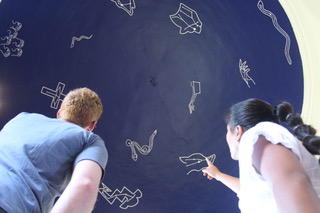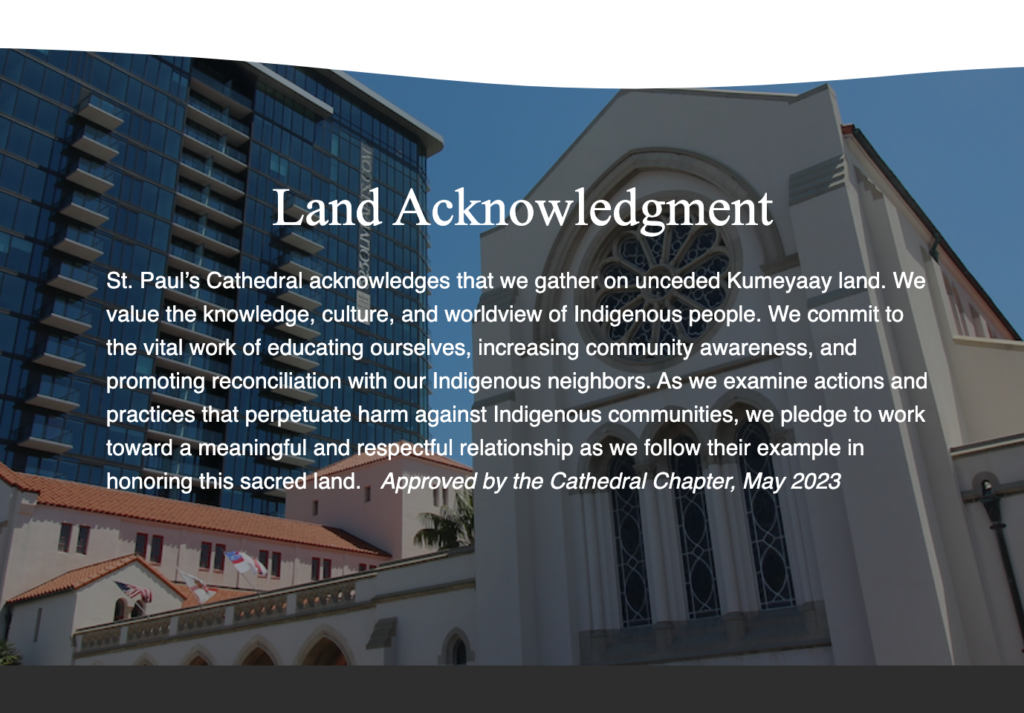
From Diane Lopez Hughes
A few years ago three Simpler Living and Sacred Ground in Action ministry members put our heads together to understand how St. Paul’s could compose and live out a land acknowledgment honoring the sacred ground of our Kumeyaay sisters and brothers. Around early Covid days, we were aware that many Zoom meetings began with a statement acknowledging the indigenous people of the land where the meeting originated. Last November, with the participation of several interested church members the statement was completed. Chapter approved St Paul’s Land Acknowledgment, which can be found in our Sunday bulletin and on our website, and shared before some of our ministry meetings and forums.

Land acknowledgments can be controversial, and are not welcome by all indigenous people. Those that go beyond the words of a land acknowledgment to address the wrongs done to our sisters and brothers – the original inhabitants of the land – and move into intentional action have real meaning. The way is not easy: it requires much education and deliberation finding ways to be in relationship with, advocate for and stand in solidarity with our Kumeyaay neighbors. Our church history is checkered in its relationship with the original inhabitants of this land, and we need to earn trust and slowly rebuild an honest relationship, ask hard questions of ourselves, and listen to their solutions for resolution – even reparation – that will take us beyond words and into honest communication.
So this past June thirty people, mostly from St Paul’s, enjoyed a personalized tour of exhibits at the Museum of Us that highlight the Kumeyaay people as well as diversity and inclusion generally. After a stimulating presentation by the museum CEO, Dr Micah Parzen, we toured these exhibits with others of his staff. The highlight was Kumeyaay: Native Californians/ Iipai-Tipai, which focused on the life ways, arts, and other cultural resources of our vibrant Indigenous neighbors. In addition we learned about the ways that the Museum of Us is moving forward in planning their work in consultation and relationship with the Indigenous people who are the focus of these and other works to come.
As we learned more about the inhumane treatment of Kumeyaay residents inhabiting the land which is now called Balboa Park many of us deepened our respect and concern for our Kumeyaay sisters and brothers then and now.
Some of our congregation’s comments include an appreciation for:
The current curatorial practices at the Museum of Us as they lead the country in sensitivity, inclusion, and robust collaboration through several important exhibits on race, identity, and connection;
The Museum’s promotion of the belief that those with whom they collaborate should have the final say regarding the disposition of their cultural items based on their values and perspectives;
Their honesty in sharing that the adoption of inclusion in museum practice have met with internal controversy, yet the Museum has persevered, conveyed in such a way that did not vilify he doubters;
The informative Kumeyaay cosmology dome depicting cosmological stories and beliefs; and
Their example to other museums of respect shown to Indigenous experts with whom they collaborate;
As other congregations in the diocese, the state, and Province 8 enter or continue on this journey beyond land acknowledgment, together we have been finding resources and building a support community to discuss redress and learn from each other as we face the challenges and celebrate the joys of this important ministry. Please consider joining this expression of reconciliation and love at St Paul’s!
For more information on how to get involved, contact Diane dianelopezhughes@me.com.


If we really are sincere about everywhere acknowledging that the Cathedral land really belongs to the Kumeyaay people, why don’t we just give it back to them? I’m sure they’d much prefer that over our extravagant gesturing to “follow their example in honoring this sacred land.” That would be a much more substantial Christian witness, and it might even mean something. I’m sure we’d all be glad to pay rent to the Kumeyaay people in exchange for the privilege of worshiping on their property, and no doubt they would be gracious landlords.